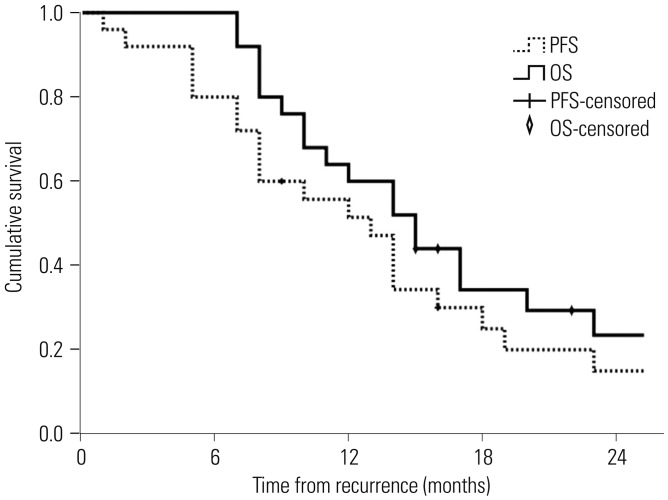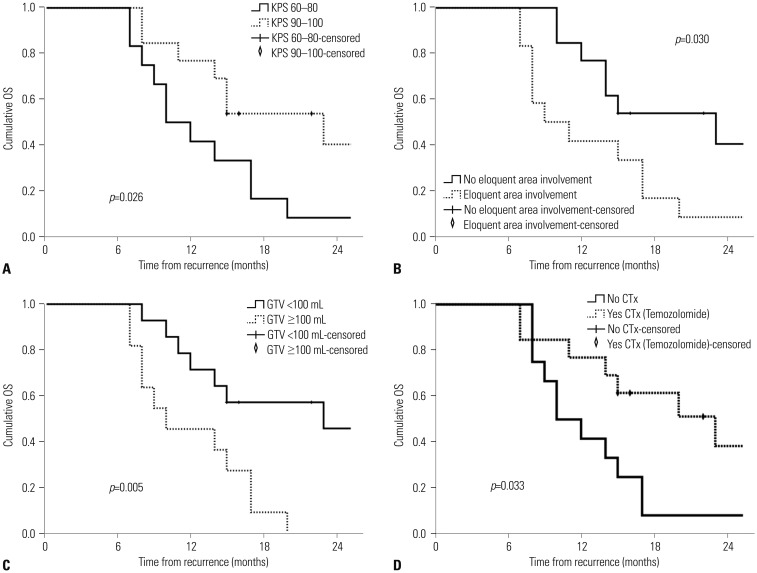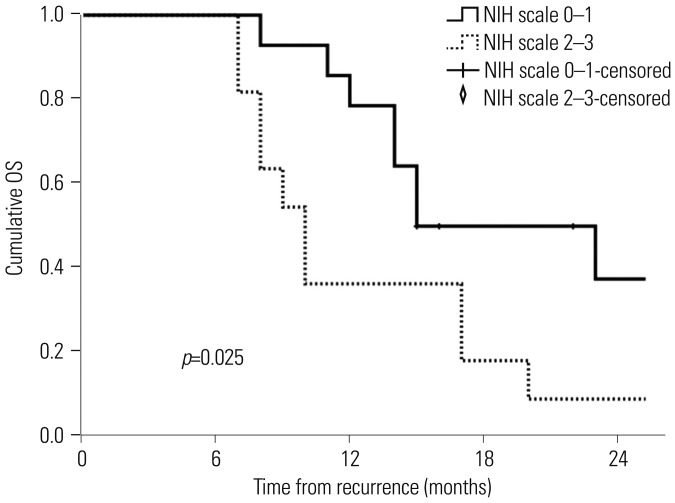Yonsei Med J.
2018 Mar;59(2):194-201. 10.3349/ymj.2018.59.2.194.
Hypofractionated Re-irradiation after Maximal Surgical Resection for Recurrent Glioblastoma: Therapeutic Adequacy and Its Prognosticators of Survival
- Affiliations
-
- 1Department of Radiation Oncology, Yonsei University College of Medicine, Seoul, Korea. cosuh317@yuhs.ac
- 2Department of Radiation Oncology, Inha University Hospital, Incheon, Korea.
- 3Department of Radiology, Yonsei University College of Medicine, Seoul, Korea.
- 4Department of Neurosurgery, Yonsei University College of Medicine, Seoul, Korea. changjh@yuhs.ac
- KMID: 2418781
- DOI: http://doi.org/10.3349/ymj.2018.59.2.194
Abstract
- PURPOSE
To evaluate the adequacy of retreatment, including hypofractionated re-irradiation (HFReRT), after surgery for recurrent glioblastoma (GBM) and related prognosticators of outcomes.
MATERIALS AND METHODS
From 2011 to 2014, 25 consecutive patients with recurrent (n=17) or secondary (n=7) disease underwent maximal surgery and subsequent HFReRT after meeting the following conditions: 1) confirmation of recurrent or secondary GBM after salvage surgery; 2) Karnofsky performance score (KPS) ≥60; and 3) interval of ≥12 months between initial radiotherapy and HFReRT. HFReRT was delivered using a simultaneous integrated boost technique, with total dose of 45 Gy in 15 fractions to the gross tumor volume (GTV) and 37.5 Gy in 15 fractions to the clinical target volume.
RESULTS
During a median follow-up of 13 months, the median progression-free and overall survival (OS) were 13 and 16 months, respectively. A better KPS (p=0.026), no involvement of the eloquent area at recurrence (p=0.030), and a smaller GTV (p=0.005) were associated with better OS. Additionally, OS differed significantly between risk groups stratified by the National Institutes of Health Recurrent GBM Scale (low-risk vs. high-risk, p=0.025). Radiologically suspected radiation necrosis (RN) was observed in 16 patients (64%) at a median of 9 months after HFReRT, and 8 patients developed grade 3 RN requiring hospitalization.
CONCLUSION
HFReRT after maximal surgery prolonged survival in selected patients with recurrent GBM, especially those with small-sized recurrences in non-eloquent areas and good performance.
Keyword
MeSH Terms
-
Adult
Brain Neoplasms/mortality/pathology/*therapy
Dose Hypofractionation
Female
Glioblastoma/mortality/pathology/*therapy
Humans
Karnofsky Performance Status
Male
Middle Aged
Neoplasm Recurrence, Local/mortality/pathology/*therapy
Prognosis
*Radiosurgery
Re-Irradiation/*methods
Salvage Therapy/methods
Survival Rate
Treatment Outcome
Figure
Reference
-
1. Stupp R, Mason WP, van den Bent MJ, Weller M, Fisher B, Taphoorn MJ, et al. European Organisation for Research and Treatment of Cancer Brain Tumor and Radiotherapy Groups. National Cancer Institute of Canada Clinical Trials Group. Radiotherapy plus concomitant and adjuvant temozolomide for glioblastoma. N Engl J Med. 2005; 352:987–996. PMID: 15758009.
Article2. Milano MT, Okunieff P, Donatello RS, Mohile NA, Sul J, Walter KA, et al. Patterns and timing of recurrence after temozolomide-based chemoradiation for glioblastoma. Int J Radiat Oncol Biol Phys. 2010; 78:1147–1155. PMID: 20207495.
Article3. Stupp R, Hegi ME, Mason WP, van den, Taphoorn MJ, Janzer RC, et al. European Organisation for Research and Treatment of Cancer Brain Tumour and Radiation Oncology Groups. National Cancer Institute of Canada Clinical Trials Group. Effects of radiotherapy with concomitant and adjuvant temozolomide versus radiotherapy alone on survival in glioblastoma in a randomised phase III study: 5-year analysis of the EORTC-NCIC trial. Lancet Oncol. 2009; 10:459–466. PMID: 19269895.
Article4. Brandes AA, Tosoni A, Franceschi E, Sotti G, Frezza G, Amistà P, et al. Recurrence pattern after temozolomide concomitant with and adjuvant to radiotherapy in newly diagnosed patients with glioblastoma: correlation with MGMT promoter methylation status. J Clin Oncol. 2009; 27:1275–1279. PMID: 19188675.
Article5. Sherriff J, Tamangani J, Senthil L, Cruickshank G, Spooner D, Jones B, et al. Patterns of relapse in glioblastoma multiforme following concomitant chemoradiotherapy with temozolomide. Br J Radiol. 2013; 86:20120414. PMID: 23385995.
Article6. Taunk NK, Moraes FY, Escorcia FE, Mendez LC, Beal K, Marta GN. External beam re-irradiation, combination chemoradiotherapy, and particle therapy for the treatment of recurrent glioblastoma. Expert Rev Anticancer Ther. 2016; 16:347–358. PMID: 26781426.
Article7. Montemurro N, Perrini P, Blanco MO, Vannozzi R. Second surgery for recurrent glioblastoma: a concise overview of the current literature. Clin Neurol Neurosurg. 2016; 142:60–64. PMID: 26811867.
Article8. Barbagallo GM, Jenkinson MD, Brodbelt AR. ‘Recurrent’ glioblastoma multiforme, when should we reoperate? Br J Neurosurg. 2008; 22:452–455. PMID: 18568742.
Article9. Park JK, Hodges T, Arko L, Shen M, Dello Iacono D, McNabb A, et al. Scale to predict survival after surgery for recurrent glioblastoma multiforme. J Clin Oncol. 2010; 28:3838–3843. PMID: 20644085.
Article10. Park CK, Kim JH, Nam DH, Kim CY, Chung SB, Kim YH, et al. A practical scoring system to determine whether to proceed with surgical resection in recurrent glioblastoma. Neuro Oncol. 2013; 15:1096–1101. PMID: 23800677.
Article11. Shi W, Palmer JD, Werner-Wasik M, Andrews DW, Evans JJ, Glass J, et al. Phase I trial of panobinostat and fractionated stereotactic re-irradiation therapy for recurrent high grade gliomas. J Neurooncol. 2016; 127:535–539. PMID: 26821711.
Article12. Wuthrick EJ, Curran WJ Jr, Camphausen K, Lin A, Glass J, Evans J, et al. A pilot study of hypofractionated stereotactic radiation therapy and sunitinib in previously irradiated patients with recurrent high-grade glioma. Int J Radiat Oncol Biol Phys. 2014; 90:369–375. PMID: 25104067.
Article13. Fogh SE, Andrews DW, Glass J, Curran W, Glass C, Champ C, et al. Hypofractionated stereotactic radiation therapy: an effective therapy for recurrent high-grade gliomas. J Clin Oncol. 2010; 28:3048–3053. PMID: 20479391.
Article14. Nieder C, Astner ST, Mehta MP, Grosu AL, Molls M. Improvement, clinical course, and quality of life after palliative radiotherapy for recurrent glioblastoma. Am J Clin Oncol. 2008; 31:300–305. PMID: 18525311.
Article15. Kong DS, Lee JI, Park K, Kim JH, Lim DH, Nam DH. Efficacy of stereotactic radiosurgery as a salvage treatment for recurrent malignant gliomas. Cancer. 2008; 112:2046–2051. PMID: 18338759.
Article16. Lee J, Cho J, Chang JH, Suh CO. Re-irradiation for recurrent gliomas: treatment outcomes and prognostic factors. Yonsei Med J. 2016; 57:824–830. PMID: 27189273.
Article17. Vogelbaum MA. The benefit of surgical resection in recurrent glioblastoma. Neuro Oncol. 2016; 18:462–463. PMID: 26869588.
Article18. Scorsetti M, Navarria P, Pessina F, Ascolese AM, D'Agostino G, Tomatis S, et al. Multimodality therapy approaches, local and systemic treatment, compared with chemotherapy alone in recurrent glioblastoma. BMC Cancer. 2015; 15:486. PMID: 26118437.
Article19. Na A, Haghigi N, Drummond KJ. Cerebral radiation necrosis. Asia Pac J Clin Oncol. 2014; 10:11–21.
Article20. Minniti G, Armosini V, Salvati M, Lanzetta G, Caporello P, Mei M, et al. Fractionated stereotactic reirradiation and concurrent temozolomide in patients with recurrent glioblastoma. J Neurooncol. 2011; 103:683–691. PMID: 21052773.
Article21. Amelio D, Amichetti M. Radiation therapy for the treatment of recurrent glioblastoma: an overview. Cancers (Basel). 2012; 4:257–280. PMID: 24213239.
Article22. Combs SE, Thilmann C, Edler L, Debus J, Schulz-Ertner D. Efficacy of fractionated stereotactic reirradiation in recurrent gliomas: long-term results in 172 patients treated in a single institution. J Clin Oncol. 2005; 23:8863–8869. PMID: 16314646.
Article23. Grosu AL, Weber WA, Franz M, Stärk S, Piert M, Thamm R, et al. Reirradiation of recurrent high-grade gliomas using amino acid PET (SPECT)/CT/MRI image fusion to determine gross tumor volume for stereotactic fractionated radiotherapy. Int J Radiat Oncol Biol Phys. 2005; 63:511–519. PMID: 16168843.
Article24. Suchorska B, Weller M, Tabatabai G, Senft C, Hau P, Sabel MC, et al. Complete resection of contrast-enhancing tumor volume is associated with improved survival in recurrent glioblastoma-results from the DIRECTOR trial. Neuro Oncol. 2016; 18:549–556. PMID: 26823503.
Article25. Grabowski MM, Recinos PF, Nowacki AS, Schroeder JL, Angelov L, Barnett GH, et al. Residual tumor volume versus extent of resection: predictors of survival after surgery for glioblastoma. J Neurosurg. 2014; 121:1115–1123. PMID: 25192475.
Article26. Sminia P, Mayer R. External beam radiotherapy of recurrent glioma: radiation tolerance of the human brain. Cancers (Basel). 2012; 4:379–399. PMID: 24213316.
Article27. Lawrence YR, Li XA, el Naqa I, Hahn CA, Marks LB, Merchant TE, et al. Radiation dose-volume effects in the brain. Int J Radiat Oncol Biol Phys. 2010; 76(3 Suppl):S20–S27. PMID: 20171513.
Article
- Full Text Links
- Actions
-
Cited
- CITED
-
- Close
- Share
- Similar articles
-
- Appraisal of re-irradiation for the recurrent glioblastoma in the era of MGMT promotor methylation
- Re-Irradiation and Its Contribution to Good Prognosisin Recurrent Glioblastoma Patients
- Radiotherapy Results of Malignant Astrocytoma and Glioblastoma Multiforme
- Postoperative Radiation Therapy of Astrocytoma and Glioblastoma Multiforme
- Radiotherapy Results of Brain Astrocytoma and glioblastoma Multiforme




